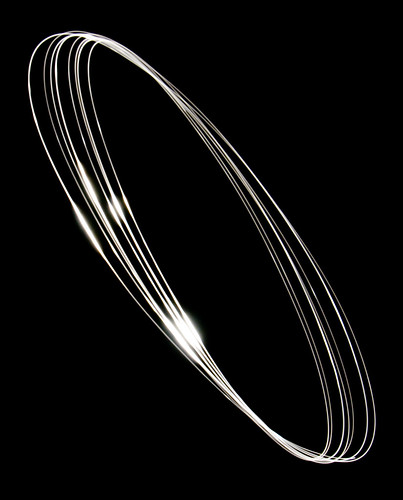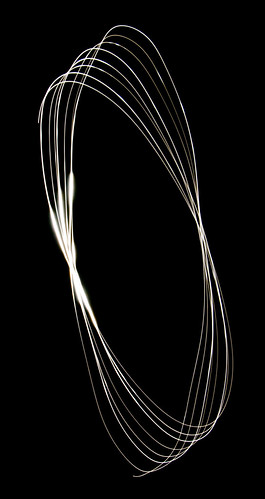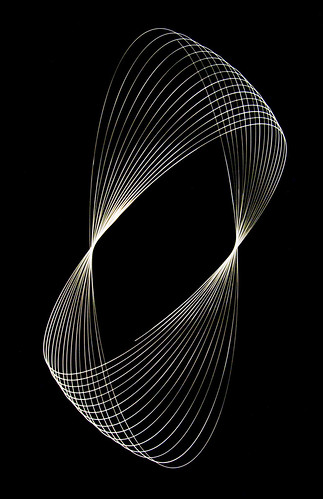Physiograms
Thanks to a Flickr friend and a fellow ham radio operator, John, I was introduced to and inspired to try making a physiogram. It's just a fancy term for a photographic pattern created by moving a point of light over a photo-sensitive surface or with a camera. The basic idea with a camera is to put your camera on the floor looking up in a dark room with the camera focused on a flashlight on a piece of string hanging directly over the camera. By putting a cover with a pinhole over the flashlight lens, you have a point of light. By swinging the flashlight and using a long exposure time, you paint a line of light as the pendulum swings. The patterns remind me of results I got with a Spirograph as a kid.
It actually sounds easier than it is. I got things set up in the basement a few days ago and once the sun went down I started experimenting. It took a bit to get the right exposure settings / film speed to capture the light properly. Here are my first attempts. They aren't great. In the first photo, the spacing between lines from successive cycles varies a lot and there are some 'hot spots' with the exposure. The second photo has those problems and also you'll notice the lines aren't smooth curves -- there is some wobble. Also I couldn't get good travel through a large arc.

So after consulting with John and doing some thinking about the causes, I was able to improve my results. First, I wasn't getting a smooth release of the light so there was some wobbling. Holding the flashlight at its center of mass when you release it helps a lot to prevent wobble of the light. Second, the irregular path in the second photo was caused by an off center pinhole in the cardboard covering the flashlight and the fact that the light wasn't hanging straight. When you release the light, it inevitably spins a bit on the string. If the pinhole is off center, the result is a wobble in the light when swinging. Third, the irregular spacing and lack of turning was caused by a d-ring thru a screw eye in the ceiling that was supporting the pendulum. I ran the string through the d-ring because I was too lazy to take a minute, grab the step stool, and put the string the screw eye directly. The d-ring swings a bit, but preferentially in certain directions. It also doesn't have the same travel as the string. That caused the irregular spacing and lack of movement.
On my next set, I used aluminum foil to cover the flashlight and used a pin to make a hole right in the center. I rigged a wire loop symmetrically around the flashlight so it would hang straight. Finally, I ran the string directly through the screw eye. The photos below are the results after those tweeks and some practice on smooth starts of the pendulum. Comparing these to the above pair you can see the improvement. The first photo is taken with the reflector still in the flashlight. That makes some light come out at large angles from the pinhole that gives the arcs a metallic reflection appearance. The second photo has the reflector removed so the light is a single beam coming out. They have different characters, but I like them both. Any preferences? I have some other ideas for future trials.




1 comment:
thanks for helpfull explanation
Post a Comment